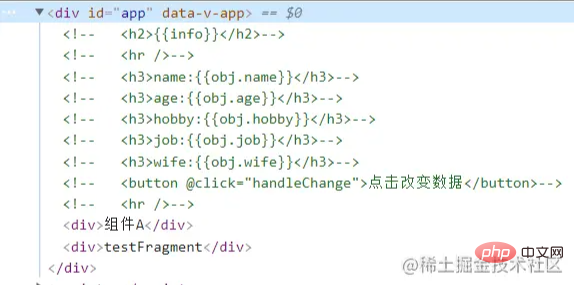Quickly understand the Fragment, Suspense, and Portal features in Vue3
This article will take you through the three new features in Vue3: Fragment (fragmented node), Suspense (asynchronous component), and Portal (portal). I hope it will be helpful to you.

#vue3 has added some new features to solve the criticisms in vue2 that hurt developers. At the same time, the performance in vue2 has also been optimized. This article will take you to explore how to use the new Fragment, Teleport and Suspense in vue3.
Fragment(Fragmentation node)
I don’t know if you have encountered the error message in the picture below in vue2:

This is the error message thrown by vue2. This means that a component can only have one root element. When we create a new vue page, there are usually multiple different element nodes. We will wrap a div in the outermost layer to make it the root node of this page. But this is not friendly. Sometimes we don't need this div element.
This problem is solved in vue3. A new dom-like tag element <fragment></fragment> has been added to vue3. If there are multiple element nodes in the vue page. Then vue will add a <fragment></fragment> tag to these element nodes when compiling. And the tag will not appear in the dom tree.

Suspense(Asynchronous component)
Vue3 provides a <suspense></suspense>Component is used to control asynchronous components.
//创建一个异步组件
<script>
const { createApp,defineAsyncComponent } = Vue
const app = createApp({})
const AsyncComp = defineAsyncComponent(
() =>
new Promise((resolve, reject) => {
setTimeout(() => resolve({
template: '<div>I am async!</div>'
}),3000)
})
)
app.component('async-component', AsyncComp)
app.mount('#app')
</script>Wrap the asynchronous component with Suspenseasync-component
<Suspense>
<template #default>
<async-component />
</template>
<template #fallback>
Loading ...
</template>
</Suspense>The asynchronous component above uses a timer and will display the component after 3 seconds. You can define an asynchronous component by providing a series of parameters by defineAsyncComponent
import { defineAsyncComponent } from 'vue'
const AsyncComp = defineAsyncComponent({
// 工厂函数
loader: () => import('./Foo.vue'),
// 加载异步组件时要使用的组件
loadingComponent: LoadingComponent,
// 加载失败时要使用的组件
errorComponent: ErrorComponent,
// 在显示 loadingComponent 之前的延迟 | 默认值:200(单位 ms)
delay: 200,
// 如果提供了 timeout ,并且加载组件的时间超过了设定值,将显示错误组件
// 默认值:Infinity(即永不超时,单位 ms)
timeout: 3000,
// 定义组件是否可挂起 | 默认值:true
suspensible: false,
/**
*
* @param {*} error 错误信息对象
* @param {*} retry 一个函数,用于指示当 promise 加载器 reject 时,加载器是否应该重试
* @param {*} fail 一个函数,指示加载程序结束退出
* @param {*} attempts 允许的最大重试次数
*/
onError(error, retry, fail, attempts) {
if (error.message.match(/fetch/) && attempts <= 3) {
// 请求发生错误时重试,最多可尝试 3 次
retry()
} else {
// 注意,retry/fail 就像 promise 的 resolve/reject 一样:
// 必须调用其中一个才能继续错误处理。
fail()
}
}
})When suspensible in the configuration item is true, the asynchronous component wrapped by Suspense will be Control
Portal(Portal)
In vue2 we may use component libraries such as element-ui, iview, etc. Sometimes we will find these ui component libraries Some component rendering levels are not included in vue dom. The hierarchy of components such as modal toast is outside the vue dom. This level outside of vue facilitates our global processing and management. Vue3 provides a pair of <teleport ></teleport> for moving the dom hierarchy
<div id="app">
<h1 id="Hello-nbsp-Async-nbsp-Component">Hello Async Component</h1>
<com-a />
</div>
<div class="i-can-fly"></div>
// 组件a
const { createApp } = Vue
const componentA = {
template: `<com-b><com-b/><div class="i-can-fly">我能瞬间移动</div>`
}
const componentB ={
template: `<div class="i-can-fly">我能飞</div>`
}
const app = createApp({})
app.component('com-b',componentB)
app.component('com-a',componentA)
app.mount('#app')At this time we open the console to view the elements
The rendering results are as follows. Then we modify the code and add the teleport tag
<div id="app">
<----...--->
<teleport to=".i-can-fly">
<com-a />
</teleport>
</div>
<div class="i-can-fly"></div>At this time we find that component B is no longer in the app. Instead, it appears in the div with the class selector i-can-fly.
It is worth noting that the to parameter on the teleport label indicates the location to which the package content is to be moved.
[Related recommendations: vue.js tutorial]
The above is the detailed content of Quickly understand the Fragment, Suspense, and Portal features in Vue3. For more information, please follow other related articles on the PHP Chinese website!

Hot AI Tools

Undresser.AI Undress
AI-powered app for creating realistic nude photos

AI Clothes Remover
Online AI tool for removing clothes from photos.

Undress AI Tool
Undress images for free

Clothoff.io
AI clothes remover

AI Hentai Generator
Generate AI Hentai for free.

Hot Article

Hot Tools

Notepad++7.3.1
Easy-to-use and free code editor

SublimeText3 Chinese version
Chinese version, very easy to use

Zend Studio 13.0.1
Powerful PHP integrated development environment

Dreamweaver CS6
Visual web development tools

SublimeText3 Mac version
God-level code editing software (SublimeText3)

Hot Topics
 1377
1377
 52
52
 vue3+vite: How to solve the error when using require to dynamically import images in src
May 21, 2023 pm 03:16 PM
vue3+vite: How to solve the error when using require to dynamically import images in src
May 21, 2023 pm 03:16 PM
vue3+vite:src uses require to dynamically import images and error reports and solutions. vue3+vite dynamically imports multiple images. If vue3 is using typescript development, require will introduce image errors. requireisnotdefined cannot be used like vue2 such as imgUrl:require(' .../assets/test.png') is imported because typescript does not support require, so import is used. Here is how to solve it: use awaitimport
 How to use tinymce in vue3 project
May 19, 2023 pm 08:40 PM
How to use tinymce in vue3 project
May 19, 2023 pm 08:40 PM
tinymce is a fully functional rich text editor plug-in, but introducing tinymce into vue is not as smooth as other Vue rich text plug-ins. tinymce itself is not suitable for Vue, and @tinymce/tinymce-vue needs to be introduced, and It is a foreign rich text plug-in and has not passed the Chinese version. You need to download the translation package from its official website (you may need to bypass the firewall). 1. Install related dependencies npminstalltinymce-Snpminstall@tinymce/tinymce-vue-S2. Download the Chinese package 3. Introduce the skin and Chinese package. Create a new tinymce folder in the project public folder and download the
 How Vue3 parses markdown and implements code highlighting
May 20, 2023 pm 04:16 PM
How Vue3 parses markdown and implements code highlighting
May 20, 2023 pm 04:16 PM
Vue implements the blog front-end and needs to implement markdown parsing. If there is code, it needs to implement code highlighting. There are many markdown parsing libraries for Vue, such as markdown-it, vue-markdown-loader, marked, vue-markdown, etc. These libraries are all very similar. Marked is used here, and highlight.js is used as the code highlighting library. The specific implementation steps are as follows: 1. Install dependent libraries. Open the command window under the vue project and enter the following command npminstallmarked-save//marked to convert markdown into htmlnpmins
 How to refresh partial content of the page in Vue3
May 26, 2023 pm 05:31 PM
How to refresh partial content of the page in Vue3
May 26, 2023 pm 05:31 PM
To achieve partial refresh of the page, we only need to implement the re-rendering of the local component (dom). In Vue, the easiest way to achieve this effect is to use the v-if directive. In Vue2, in addition to using the v-if instruction to re-render the local dom, we can also create a new blank component. When we need to refresh the local page, jump to this blank component page, and then jump back in the beforeRouteEnter guard in the blank component. original page. As shown in the figure below, how to click the refresh button in Vue3.X to reload the DOM within the red box and display the corresponding loading status. Since the guard in the component in the scriptsetup syntax in Vue3.X only has o
 How to use Vue3 reusable components
May 20, 2023 pm 07:25 PM
How to use Vue3 reusable components
May 20, 2023 pm 07:25 PM
Preface Whether it is vue or react, when we encounter multiple repeated codes, we will think about how to reuse these codes instead of filling a file with a bunch of redundant codes. In fact, both vue and react can achieve reuse by extracting components, but if you encounter some small code fragments and you don’t want to extract another file, in comparison, react can be used in the same Declare the corresponding widget in the file, or implement it through renderfunction, such as: constDemo:FC=({msg})=>{returndemomsgis{msg}}constApp:FC=()=>{return(
 How to select an avatar and crop it in Vue3
May 29, 2023 am 10:22 AM
How to select an avatar and crop it in Vue3
May 29, 2023 am 10:22 AM
The final effect is to install the VueCropper component yarnaddvue-cropper@next. The above installation value is for Vue3. If it is Vue2 or you want to use other methods to reference, please visit its official npm address: official tutorial. It is also very simple to reference and use it in a component. You only need to introduce the corresponding component and its style file. I do not reference it globally here, but only introduce import{userInfoByRequest}from'../js/api' in my component file. import{VueCropper}from'vue-cropper&
 How to use vue3+ts+axios+pinia to achieve senseless refresh
May 25, 2023 pm 03:37 PM
How to use vue3+ts+axios+pinia to achieve senseless refresh
May 25, 2023 pm 03:37 PM
vue3+ts+axios+pinia realizes senseless refresh 1. First download aiXos and pinianpmipinia in the project--savenpminstallaxios--save2. Encapsulate axios request-----Download js-cookienpmiJS-cookie-s//Introduce aixosimporttype{AxiosRequestConfig ,AxiosResponse}from"axios";importaxiosfrom'axios';import{ElMess
 How to use defineCustomElement to define components in Vue3
May 28, 2023 am 11:29 AM
How to use defineCustomElement to define components in Vue3
May 28, 2023 am 11:29 AM
Using Vue to build custom elements WebComponents is a collective name for a set of web native APIs that allow developers to create reusable custom elements (customelements). The main benefit of custom elements is that they can be used with any framework, even without one. They are ideal when you are targeting end users who may be using a different front-end technology stack, or when you want to decouple the final application from the implementation details of the components it uses. Vue and WebComponents are complementary technologies, and Vue provides excellent support for using and creating custom elements. You can integrate custom elements into existing Vue applications, or use Vue to build






